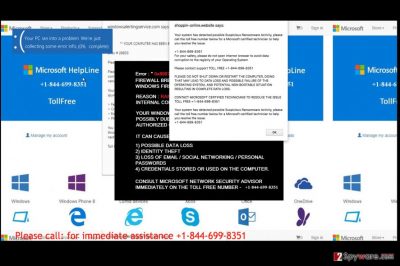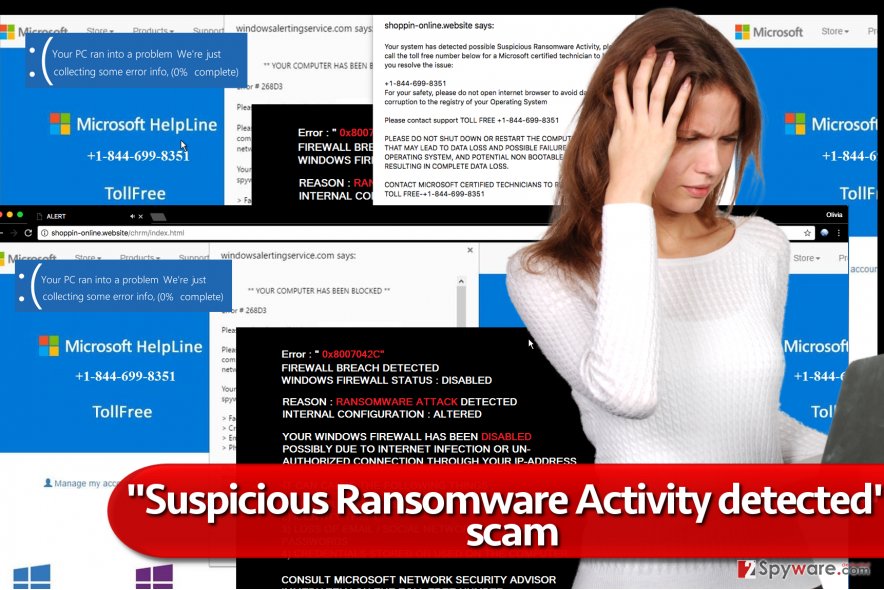“Suspicious Ransomware Activity detected” Tech Support Scam virus (Easy Removal Guide) - Microsoft Support Scam
“Suspicious Ransomware Activity detected” Tech Support Scam virus Removal Guide
What is “Suspicious Ransomware Activity detected” Tech Support Scam virus?
Tech support scammers started new “Suspicious Ransomware Activity detected” scam – learn how to identify it
“Suspicious Ransomware Activity detected” tech support scam virus[1] is a malicious computer program that redirects the victim to phishing web pages and seeks to convince him that computer has been infected with ransomware or a similar malicious virus. Such deceptive program will redirect to deceptive websites such as shoppin-online[.]website and display misleading messages on the screen, asking to call “Microsoft certified technicians” at +1-844-699-8351.
This particular site contains every possible Microsoft logo and even the “Your PC ran into a problem” message which is familiar to every computer user. If such site appeared on your screen, we suggest you remove “Suspicious Ransomware Activity detected” scam right away. The website then goes full-screen and triggers a message from a web page, saying:
Your system has detected possible Suspicious Ransomware Activity, please call the toll free number below for a Microsoft certified technician to help you resolve the issue.

The malicious virus keeps repeating that the victim has to get in touch with these technicians in order to resolve the issue. However, we must inform you that scammers cannot remotely identify “suspicious ransomware activity” because once ransomware strikes, it encrypts all files in a few seconds, besides, Microsoft would never attempt to display some warnings via your web browser.
The only way that Microsoft could inform you that a ransomware attack was identified and stopped is by showing a message from Windows Defender. However, if you use a different anti-spyware or anti-malware software, Windows Defender will be disabled, and the responsibility for your computer’s protection will be passed to your chosen security program.
The virus displays repetitious warnings, threatening the victim that taking any arbitrary actions will result in complete data loss or failure of the operating system. Do not believe such statements as they are entirely deceptive. People who work in underground offices will pick up the phone if you dial the number provided, and tell you all kinds of lies just to convince you to do one of the following:
- Provide personal data such as credit card details, name, email, and more;
- Purchase scam software packs for an enormous price;
- Provide remote access to the computer for the attackers so that they can plant even more malware on the system[2].

You should take actions to protect your privacy and operating system by performing a full “Suspicious Ransomware Activity detected” removal. We highly recommend you to download FortectIntego or SpyHunter 5Combo Cleaner software, update it and perform a system scan with it to identify and eliminate the program that sends these deceptive pop-ups to you.
Distribution and promotion of tech support scam malware
There are two ways to land on a phishing website registered by tech support scammers. Usually, victims accidentally visit such websites after installing ad-serving malware on their computers, although they can unconsciously install tech support scam malware by opening shady links or files added to emails sent to them by strangers. If the “Suspicious Ransomware Activity detected” pop-up started appearing on your screen, you must identify the malicious software placed on your PC and wipe it off the system along with all of its components.
Sometimes, people install shady software alongside freeware such as media players, file converters, and similar programs. To bypass potential risks of installing dangerous additions, make sure you select Custom or Advanced installation settings and remove every check mark placed next to agreement to install suggested extras.
Removing “Suspicious Ransomware Activity detected” malware can be tricky
Even if you are an experienced computer user, it can be hard to remove Suspicious Ransomware Activity virus because it can hide in your PC under a variety of different names. Therefore, we recommend running a scan with anti-malware software that can thoroughly check each file and see if it contains malicious functions. We do not recommend you to try to perform a manual “Suspicious Ransomware Activity detected” removal because if it results in failure, you can do more harm than good. We suggest you restart your PC into Safe Mode with Networking before launching the security program.
Getting rid of “Suspicious Ransomware Activity detected” Tech Support Scam virus. Follow these steps
Manual removal using Safe Mode
Delete the tech support virus this way:
Important! →
Manual removal guide might be too complicated for regular computer users. It requires advanced IT knowledge to be performed correctly (if vital system files are removed or damaged, it might result in full Windows compromise), and it also might take hours to complete. Therefore, we highly advise using the automatic method provided above instead.
Step 1. Access Safe Mode with Networking
Manual malware removal should be best performed in the Safe Mode environment.
Windows 7 / Vista / XP
- Click Start > Shutdown > Restart > OK.
- When your computer becomes active, start pressing F8 button (if that does not work, try F2, F12, Del, etc. – it all depends on your motherboard model) multiple times until you see the Advanced Boot Options window.
- Select Safe Mode with Networking from the list.

Windows 10 / Windows 8
- Right-click on Start button and select Settings.

- Scroll down to pick Update & Security.

- On the left side of the window, pick Recovery.
- Now scroll down to find Advanced Startup section.
- Click Restart now.

- Select Troubleshoot.

- Go to Advanced options.

- Select Startup Settings.

- Press Restart.
- Now press 5 or click 5) Enable Safe Mode with Networking.

Step 2. Shut down suspicious processes
Windows Task Manager is a useful tool that shows all the processes running in the background. If malware is running a process, you need to shut it down:
- Press Ctrl + Shift + Esc on your keyboard to open Windows Task Manager.
- Click on More details.

- Scroll down to Background processes section, and look for anything suspicious.
- Right-click and select Open file location.

- Go back to the process, right-click and pick End Task.

- Delete the contents of the malicious folder.
Step 3. Check program Startup
- Press Ctrl + Shift + Esc on your keyboard to open Windows Task Manager.
- Go to Startup tab.
- Right-click on the suspicious program and pick Disable.

Step 4. Delete virus files
Malware-related files can be found in various places within your computer. Here are instructions that could help you find them:
- Type in Disk Cleanup in Windows search and press Enter.

- Select the drive you want to clean (C: is your main drive by default and is likely to be the one that has malicious files in).
- Scroll through the Files to delete list and select the following:
Temporary Internet Files
Downloads
Recycle Bin
Temporary files - Pick Clean up system files.

- You can also look for other malicious files hidden in the following folders (type these entries in Windows Search and press Enter):
%AppData%
%LocalAppData%
%ProgramData%
%WinDir%
After you are finished, reboot the PC in normal mode.
Remove “Suspicious Ransomware Activity detected” Tech Support Scam using System Restore
If the Method 1 fails to work, try the following technique instead.
-
Step 1: Reboot your computer to Safe Mode with Command Prompt
Windows 7 / Vista / XP- Click Start → Shutdown → Restart → OK.
- When your computer becomes active, start pressing F8 multiple times until you see the Advanced Boot Options window.
-
Select Command Prompt from the list

Windows 10 / Windows 8- Press the Power button at the Windows login screen. Now press and hold Shift, which is on your keyboard, and click Restart..
- Now select Troubleshoot → Advanced options → Startup Settings and finally press Restart.
-
Once your computer becomes active, select Enable Safe Mode with Command Prompt in Startup Settings window.

-
Step 2: Restore your system files and settings
-
Once the Command Prompt window shows up, enter cd restore and click Enter.

-
Now type rstrui.exe and press Enter again..

-
When a new window shows up, click Next and select your restore point that is prior the infiltration of “Suspicious Ransomware Activity detected” Tech Support Scam. After doing that, click Next.


-
Now click Yes to start system restore.

-
Once the Command Prompt window shows up, enter cd restore and click Enter.
Finally, you should always think about the protection of crypto-ransomwares. In order to protect your computer from “Suspicious Ransomware Activity detected” Tech Support Scam and other ransomwares, use a reputable anti-spyware, such as FortectIntego, SpyHunter 5Combo Cleaner or Malwarebytes
How to prevent from getting malware
Do not let government spy on you
The government has many issues in regards to tracking users' data and spying on citizens, so you should take this into consideration and learn more about shady information gathering practices. Avoid any unwanted government tracking or spying by going totally anonymous on the internet.
You can choose a different location when you go online and access any material you want without particular content restrictions. You can easily enjoy internet connection without any risks of being hacked by using Private Internet Access VPN.
Control the information that can be accessed by government any other unwanted party and surf online without being spied on. Even if you are not involved in illegal activities or trust your selection of services, platforms, be suspicious for your own security and take precautionary measures by using the VPN service.
Backup files for the later use, in case of the malware attack
Computer users can suffer from data losses due to cyber infections or their own faulty doings. Ransomware can encrypt and hold files hostage, while unforeseen power cuts might cause a loss of important documents. If you have proper up-to-date backups, you can easily recover after such an incident and get back to work. It is also equally important to update backups on a regular basis so that the newest information remains intact – you can set this process to be performed automatically.
When you have the previous version of every important document or project you can avoid frustration and breakdowns. It comes in handy when malware strikes out of nowhere. Use Data Recovery Pro for the data restoration process.
- ^ Avoiding technical support scams. Microsoft. Safety & Security Center.
- ^ Andy Greenberg. Listen to ‘Tech Support’ Scam Calls That Bilk Victims Out of Millions. WIRED. Science, Business, Technology News.





















